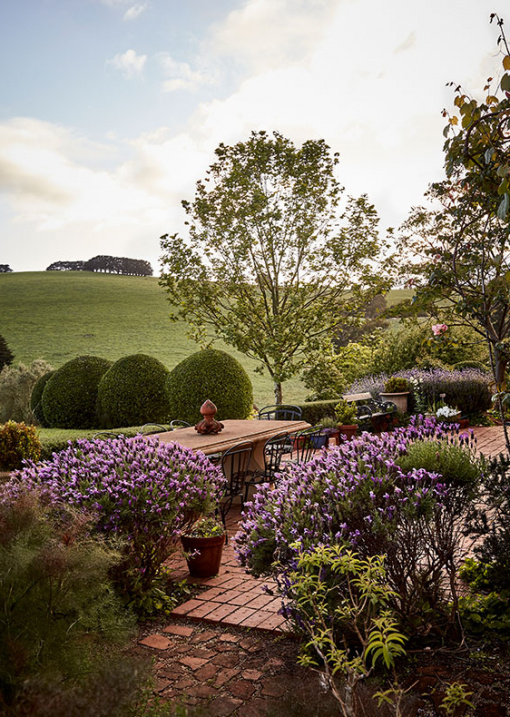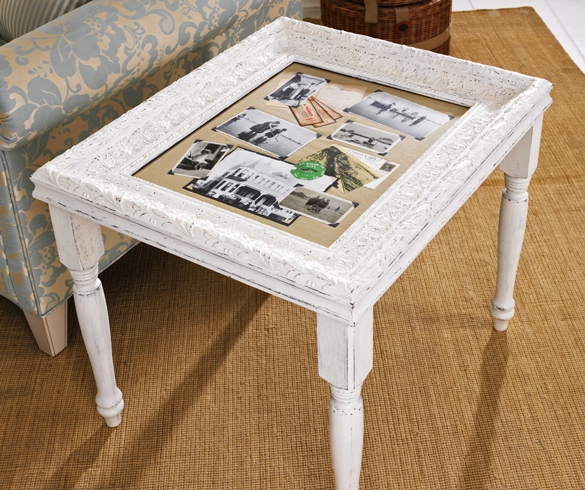Believe it or not, there had never been a building or house on this 26-acre property before Marian and Bryce Somes came along. The divided paddocks were previously used to make hay, and house grazing dairy cattle. ‘The only trees were on the roadside and along the creek, which forms one of our boundaries,’ explains Marian. ‘It was a clean slate!’
Inspired by her rural upbringing and travelling through France with her husband, Marian developed a passion for roses and homegrown vegetables. The pair of francophiles returned to Australia determined to find the perfect plot of land to create their own rural French farmhouse, settling on West Gippsland, with its high rainfall, hearty soil and rolling countryside. It was the ideal place to bring their vision to life.
Particularly inspired by Monet’s famed garden at Giverny, Marian and Bryce chose to build their house with rammed earth to give solidity to the building, and allow for the garden to creep over its frameworks. Marian and Bryce chose symmetrically placed windows and French doors to specifically resemble Giverny, while the English garden Sissinghurst became the guide for separating the garden into ‘rooms’ separated by hedges. However, that organisation also came organically, as the pair finished one section of the garden they naturally moved on to constructing the next!
‘With time, the rooms have becomes secluded, and parts of the garden are quite shady, which changes the types of plants that will grow,’ Marian explains, listing the hedge varieties as espaliered apples, pears and wild olives. Timber pergolas support climbing roses and wisteria, and a rustic arbour buttresses the winding roses. Cast-iron light brackets in the shape of roses clad the exterior of the house alongside supports for ornamental grapevines, while waterlilies cover the pond at the centre of the rose garden. The barn, dovecote and outbuildings are erected from mudbrick, the leftovers of which were used to make a traditional palais de poulet for the chickens!
The pea gravel at the front of the house came from the same quarry as the rammed earth of the main house, making the whole place feel as though it could have emerged from the earth fully formed, like a giant waking from slumber and shaking off its covering. That same sense of history and preternatural connection to the natural world is embedded in the personality of the property.
‘The outbuildings and structures are static, but the garden is constantly changing,’ Marian says, which makes it harder for her to settle on her favourite part of Picardy. It changes every day, and every season! ‘In mid spring the whole garden explodes: first the wisteria on various pergolas around the garden then roses, poppies, foxgloves and verbascum follow. To sit under the rose arbour by the son surrounded by flowers is a delight!’
Each year Marian and Bryce add something new to the garden, contributing to its evolution. ‘The challenge is not in dreaming up new gardens or making them – the challenge is maintaining them. That is an ongoing challenge.’
Find out when you can visit the beautiful grounds of Picardy Gardens in real life (when circumstances permit!) here. In the meantime, learn more about this spectacular property in ‘Picardy‘ by Marian Somes, with exquisite photography by Sue Stubbs.

The main house at Picardy is made from rammed earth with iron brackets and grapevines cladding the exterior! Photo – Sue Stubbs.

Looking out at the rolling hills of West Gippsland. Photo – Sue Stubbs.

Roses at every corner are essential to keeping up the French provincial homage. Photo – Sue Stubbs.

Hedges separate the garden into ‘rooms’. Photo – Sue Stubbs.

The arbour in the rose garden. Photo – Sue Stubbs.

Structures holding up the winding roses and wisteria are erected at every opportunity! Photo – Sue Stubbs.

Sprinkles of afternoon sunlight dapple the roses. Photo – Sue Stubbs.

A wheelbarrow taking shade. Photo – Sue Stubbs.

The dovecote. Photo – Sue Stubbs.

It really looks like we could be in rural France! Photo – Sue Stubbs.

A wood-fired oven. Photo – Sue Stubbs.

Citrus blooms in winter. Photo – Sue Stubbs.

Symmetrical windows and French doors directly reference Monet’s house at Giverny. Photo – Sue Stubbs.

Gravel pathways contain the flower beds. Photo – Sue Stubbs.

Flowers coat the infamous garden, leaving only glimpses of the house as you go deeper. Photo – Sue Stubbs.

‘The outbuildings and structures are static but the garden is constantly changing,’ says Marian. Photo – Sue Stubbs.







